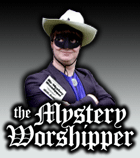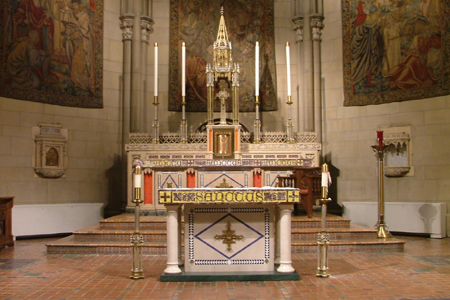| |
 |
 |
 |
| Comment on this report, or find other reports. |
 |
| Our Mystery Worshippers are volunteers who warm church pews for us around the world. If you'd like to become a Mystery Worshipper, start here. |
 |
| Find out how to reproduce this report in your church magazine or website. |
|
|
| 2668: Blessed
Sacrament, New York City |
 |
 |
 |
Mystery
Worshipper: Amanda B. Reckondwythe,
accompanied by Acton Bell.
The church:
Blessed
Sacrament, New York City.
Denomination:
Roman Catholic,
Archdiocese
of New York.
The building:
An absolute gem of a church tucked away on a quiet side street
in Manhattan’s Upper West Side. Dedicated in 1920, it is the
parish’s second building. The architect was Gustave E. Steinback,
who designed dozens of Catholic churches in the New York metropolitan
area. The interior is very French Gothic, with tapestries behind
the marble high altar. A small marble communion table sits in
front of the altar, and the original altar rail has been preserved
intact, as has the pulpit. Lots of stained glass. A beautiful
rose window graces the west gallery, atop the organ pipes. Their
website describes the building in much greater detail than I
could hope to.
The church: The parish was founded in 1887, when there were more cows, sheep and open meadows in the area than buildings, cars and people – the first mass was celebrated in a stable, of all places! Today they are a very active parish, with a soup kitchen, shelter for homeless men, outreach for seniors, and other programs. The Blessed Sacrament School offers classes for pre-kindergarten through eighth grade. There are four masses each Sunday morning, including one in Spanish, plus a Sunday evening mass, the Saturday vigil mass, and three masses on weekdays.
The neighborhood:
Blessed Sacrament Church is on West 71st Street between Broadway
and Columbus Avenue. This is Manhattan’s Upper West Side, an
upscale residential area with lots of trendy restaurants, boutiques
and cultural attractions. The church sits in the middle of a
tree-lined block of apartment buildings.
The cast:
The Revd John P. Duffell, associate; Gregory D'Agostino, A.Mus.D.,
organist and director of music.
The date & time: Second Sunday in Lent, March 16, 2014, 12.30pm.
What was the name of the service?
Choral Mass.
How full was the building?
It’s a large church – I didn’t count the pews, but it was about seven-eights full.
Did anyone welcome you personally?
No.
Was your pew comfortable?
Unpadded wooden pew – it was OK.
How would you describe the pre-service
atmosphere?
People entered quietly. A gentleman who I presume was Gregory D’Agostino, the music director, played something on the piano that sounded like Bach but I didn’t recognize what it was.
What were the exact opening words of the
service?
"Good afternoon. Welcome to Blessed Sacrament Church."
What books did the congregation use during the
service?
Word and Song 2014, a paperback combination hymnal
and prayer book.
What musical instruments were played?
Organ, originally by the Estey Organ Company of Brattleboro, Vermont – a fact of significance to me, as my great-aunt of fond memory worked for a time as a secretary in Estey’s New York showroom. The Estey instrument was replaced in 1950 by an opus of Casavant Frères Limitée of St. Hyacinthe, Québec, which incorporated much of the Estey pipework. The Casavant organ was rebuilt in 2005 by James A. Konzelman Organs of Maplewood, New Jersey. There was also a choir who sang from the gallery.
Did anything distract you?
The priest, who resembled the late great master comedian George Burns, spoke with a strong New York accent of the kind you really don’t hear anymore. "Straight out of Central Casting," Acton Bell remarked. His alb seemed a trifle too long; I’m surprised he didn’t trip over it. The choir blended well, but one soprano stood out a little from the others, and I didn’t think she always sang exactly on pitch.

Was the worship stiff-upper-lip, happy clappy, or
what?
Very nicely done mass, with dignity. The entrance procession consisted of crucifer in alb, server in cassock and surplice, eucharistic ministers in street clothes, and the priest in purple chasuble. The priest chanted most of the mass, including the eucharistic prayer in its entirety. The hymns were traditional: "Lift High the Cross", "God’s Holy Mountain We Ascend", etc. The psalm was chanted by a quartet drawn from the choir, to an Anglican chant setting. In lieu of the Nicene Creed, the priest read the renewal of baptismal vows, to which we sang after each question: "I believe, Lord; help my unbelief." We sang the Sanctus and Agnus Dei in Latin, and the Lord’s Prayer in English to the Gregorian setting. We received communion under both kinds, with most people intincting the host into the chalice.
Exactly how long was the sermon?
10 minutes.
On a scale of 1-10, how good was the preacher?
7 – I thought Father got off to a weak start, reading from his notes and not really making much sense, but he strengthened considerably toward the end of the sermon as he looked up from his notes and made better eye contact.
In a nutshell, what was the sermon
about?
All kinds of people go to church, but all believe in Jesus. Much of our lives is spent coming and going – indeed, spirituality is rooted in movement. But our journey of faith is a purposeful one, motivated by a call from God. It is a pilgrimage with a homecoming. The Transfiguration is like an oasis on that journey, with a glimpse of the glory to come at the journey’s end. God told us to listen to his Son – but do we listen? Do we become involved in social issues of the day? No one said the journey would be easy, but God never turns away from us, even when we turn away from him.

Which part of the service was like being in
heaven?
At the end of the intercessions, Father led us in singing "A
Song of Peace", to the tune Finlandia, unaccompanied.
That was a surprise, and was heavenly. The generally high caliber
of music throughout was very much appreciated and quite heavenly.
And which part was like
being in... er... the other place?
At the offertory, there was some confusion as to who would bring
the bread and wine up to the altar. Finally, a woman in the
congregation got up and beckoned for someone to accompany her,
which beckoning was soon answered by a gentleman. And although
the quality of the music was very good, I do have to fault the
soprano who stood out. I don’t think she always sang quite on
pitch; this was especially evident at communion time in her
descant to "There’s a Wideness in God’s Mercy" (sung to St
Helena, not to Beecher – I call it "the bicycle
setting" because the accompaniment reminds me of someone pedaling
a bicycle). The choir also did a polyphonic number at communion
in English – I didn't recognize it – that seemed to get off
to a shaky start pitch-wise but recovered nicely. I didn't look
up into the gallery, but I would bet that the choir were not
facing outward into the nave – had they done so, they would
have projected better.
What happened when you
hung around after the service looking lost?
Most people stayed for all three verses of "God’s Holy Mountain
We Ascend", although a handful left as soon as the priest left
the altar. Acton Bell had to visit the loo, so I snapped some
photos of the altar and rose window while I was waiting for
him. No one paid us much attention.
How would you describe the after-service
coffee?
There was none.
How would you feel about making this church your regular (where 10 = ecstatic, 0 = terminal)?
8 – It was a lovely service in a lovely church. The parish seems to be involved in a number of worthwhile activities. If I lived in the area, I would probably be back regularly.
Did the service make you feel glad to be a
Christian?
Yes.

What one thing will you remember about all this in seven days' time?
"A Song of Peace" to Finlandia. |
|
|
 |
 |
 |
| We rely on voluntary donations to stay online. If you're a regular visitor to Ship of Fools, please consider supporting us. |
 |
 |
 |
| The Mystery Pilgrim |
 |
| One of our most seasoned reporters makes the Camino pilgrimage to Santiago de Compostela in Spain. Read here. |
 |
 |
 |
| London churches |
 |
| Read reports from 70 London churches, visited by a small army of Mystery Worshippers on one single Sunday. Read here. |
| |
|
|
|
|


